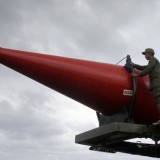The Cuban Missile Crisis that occurred just over 50 years ago can provide us with some important insights about ourselves and how we might address the global environmental challenges unfolding around us.
The Crisis, between Monday, October 16th and Sunday, October 28th, 1962, was 13 days of the Cold War that came despairingly close to becoming an extremely hot nuclear Armageddon that could have incinerated both the Soviet Union and the United States.
The scenario was set when the Cuban revolution ended. Fidel Castro had declared his country a communist state and had allied with the USSR. To protect its new strategic interests just a few convenient miles from Florida, the Soviets had stationed some 40,000 troops in Cuba and used the opportunity to balance the nuclear threat coming from the United States by installing both short and long-range missiles on the island. To halt this threat, the US countered with a naval blockade 500 miles from Cuba, warning that any ships that crossed that line would be sunk. The Soviets countered by defending their interests with submarines carrying nuclear-tipped torpedoes.
The background details are even more scary. America’s failed invasion of Cuba the year before at the Bay of Pigs had convinced a volatile Castro that war was inevitable, so he was urging the Soviets to strike the US with nuclear missiles before it could launch another attack. Meanwhile, the hawks in the US military and Congress were urging President John F. Kennedy to bomb the Soviet’s Cuban missile installations. Nikita Khrushchev, the Soviet leader, had his own military hawks to worry about, in addition to an unpredictable and uncontrollable Castro. Professor David Welch of the Political Science Department of the University of Waterloo writes that the whole situation “was an incredibly messy, dangerous interaction” (Globe & Mail, Oct. 15/12). Both Kennedy and Khrushchev were “scared to death” about actions their bellicose generals might initiate if not closely supervised, and both leaders were sometimes out of communication with their military.
Two incidents illustrate the precariousness of the situation. In one instance, in the middle of the Crisis and against standing orders, a Soviet general shot down an unarmed US high-altitude spy plane over Cuba. In a second instance, US warships were dropping depth charges on a Soviet submarine that had violated the blockade. The submarine’s captain decided to launch a nuclear-tipped torpedo at the American warships, an event that could have ignited a full nuclear exchange between America and the Soviets. Only impassioned pleas from the Soviet sub’s crew dissuaded the captain from launching the torpedo (John Ibbitson, Globe & Mail, Jul. 30/08).
When the Crisis ended on October 28th, the only fatality was the spy plane’s pilot — and, of course, truth. American propaganda praised the US military for staring down the Soviets, creating the mythology that unilateral power can win in such circumstances. The reality was very different. Kennedy and Khrushchev were in frequent communication, and neither wanted a nuclear exchange. The Secretary-General of the United Nations, U Thant, negotiated between two hastily assembled diplomatic groups at UN headquarters, while also managing to subdue the volatile Castro. By agreement, the Americans would not invade Cuba, the Soviets would take their missiles back to the USSR, the body of the pilot would be returned to the US, and the American missiles in Turkey that threatened the Soviets would be secretly removed.
The Cuban Missile Crisis has its parallel in the global environmental challenges now unfolding around us. The threat is not nuclear annihilation but a gradual increase in ecological and climate disturbances that will trigger all manner of political conflicts relating to oceanic fish resources, Arctic sovereignty, refugee migrations, water allocations, technology sharing, food stresses, population management, mitigation costs, economic inequality, property damage and humanitarian assistance.
Driving and exacerbating these conflicts are greenhouse gas emissions. They are the nuclear bombs slowly but inexorably exploding in every nation around the world. The Climate Vulnerable Forum, a 20-country gathering of scientists, economists and policy strategists estimates that abnormal weather is already causing $1.6 trillion in damage every year, reducing GDP by 1.6 percent and killing 400,000 people (Ibid. Eric Reguly, Sept. 29/12). These emissions must come down. How will this happen? What will the national commitments be? Who will monitor, supervise and enforce them? How will the global financial system be adjusted to facilitate emission reductions? Should some high emitting nations compensate others for damage? What are the ethical and moral dimensions of this profoundly human and ecological event?
Bluster and bravado are counterproductive when everyone is responsible. Might and power are negated when when everyone is the victim. Negotiations, diplomacy, sharing, co-operating, helping and compromising are going to be the new watchwords when no one can win without everyone losing.
Climate change is like another threatening nuclear holocaust. It’s going to spin out of control if the “generals” of industry push the limits of brinkmanship. The consequences will be devastating if the “Kennedys” and “Khrushchevs” of the world don’t have the imagination to gauge the severity of the situation. As with the Cuban Missile Crisis, we need an international forum like the United Nations to mediate, negotiate and communicate the complexities of this issue so it can be resolved for the benefit of all. Failure will leave no heroes or victors.

